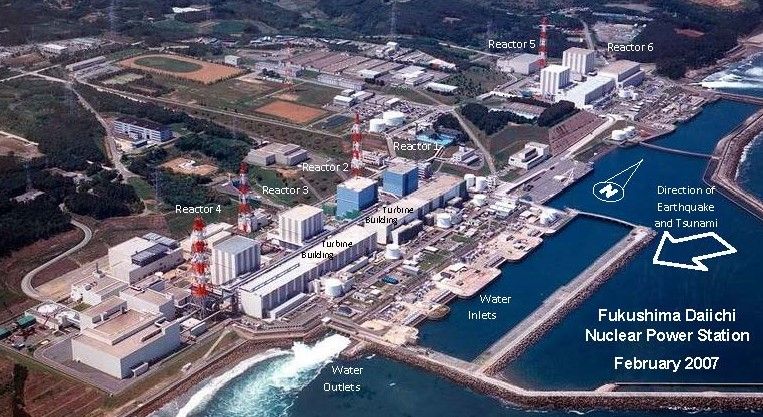On 11 March, 2011, an enormous earthquake off the eastern shore of Japan triggered a tsunami that wrecked four of the six fission reactors at the Fukushima Daiichi power station, as well the nearby power station Fukushima Daini which shutdown but escaped damage. Located about 75 miles north of Tokyo, Fukushima disaster is the third worst nuclear disaster after Chernobyl, Ukraine in 1986 and Mayak, Russia in 1957.
Following up on his 2016 book Chernobyl 01:23:40 about the 1986 catastrophe behind the Iron Curtain, Andrew Leatherbarrow – an author, graphic designer and photographer – recounts the history of electric power generation in Japan and in particular its introduction of nuclear power in his latest book Melting Sun. Published this year, Melting Sun reveals the politically and socially interwoven influences that promoted aggressive development in the face of limited fossil fuel resources along with the anemic regulatory oversight that neglected the tectonic instability along the Pacific Rim. His summary in The American Conservative serves as an introduction to this detailed investigation.
Despite ostensive demands for reducing atmospheric release of carbon dioxide from chemical combustion, nuclear power has languished in much of the industrialized world. Political opposition and regulatory impediments have stymied expansion of this mature technology, in part due to the non-intuitive complexity of such processes, as well as secrecy surrounding the ability of atomic disintegration to be exploited for highly explosive weapons.
The Ignorance (and Fear) of Nuclear Power
Before commenting on the cultural nature of Japanese society, a brief segue into nuclear power generation seems in order. Electric power – meaning energy produced per time transmitted by electromagnetic conduction – converts mechanical work through rotating inductive magnetic fields. The work can be provided by a motive force, such as falling water as in a hydroelectric dam, or from steam passing through a turbine. The steam in turn results from heating water to boiling – and this can be accomplished by burning fossil fuels, such as coal, oil or natural gas, or else by nuclear fission, as explained in my primer.
There are several nuclear reactor types but most commercial facilities – whether on land or aboard naval craft – employ water as the heat exchanger coolant as well as the moderator for decelerating the neutrons emitted from the reaction. By contrast, the Soviet Union employed an RBMK design that used graphite as the moderator. Other designs employ sodium or helium as the coolant.
The uranium used for fuel is typically packed into zirconium-clad rods and inserted into a reinforced reaction chamber. A coolant, such as water, passes along the rods as the uranium nuclei divide into decay products. The fission process releases heat to be absorbed by the coolant for conversion to mechanical and electrical energy. Control rods can be inserted to absorb neutrons and suspend further uranium fission, although heat release continues from secondary nuclear decay. Some reactors use a fuel mixture combining uranium and plutonium, operating under the same physical principles.
Many configurations have been built and tested, but commercial power generation usually incorporates water-based designs. The two most common types are the boiling water reactor (BWR) and the pressurized water reactor (PWR). The former boils water in the chamber at about 72 atmospheres before converting the thermal energy through a turbine. The latter keeps the water liquid at 153 atmospheres and transfers this thermal energy to a transfer loop via a heat exchanger. The water in the transfer loop boils to turn the turbine. Each configuration has particular advantages and disadvantages. Both reactor types require active pumping of water to maintain steady temperature. Coolant failure causes the fuel rods to melt into radioactive slag – and oxidize the zirconium cladding to produce hydrogen gas, which when ignited by a spark causes violent explosions that burst their internal structures.
Currently France operates 56 PWRs supplying about 70% of that nation’s power – the most in the world. As of last year, the United States commercially operated 62 PWRs and 31 BWRs, together producing about 20 percent of tour country’s power. Prior to the Tōhoku earthquake, Japan operated 54 reactors generating about 30% of its electrical power. These included 29 BWRs and 24 PWRs. After the Fukushima disaster that rendered four BWRs inoperable, Japan shut down all its reactors. Since the introduction of new regulatory standards, ten PWRs have resumed operations, while 12 BWRs and 9 PWRs remain shutdown.
Long Road of Failures at Fukushima
So what happened? Starting from late nineteenth century history, Leatherbarrow explains that Japan sought energy independence as its coal reserves depleted by harnessing nuclear fission, despite having been subjected to bombs based on those principles. National energy needs provided the impetus to encourage or even compel sparsely populated coastal prefectures into accepting nuclear power installations. Recognizing the geography’s vulnerability to seismic disturbances, government ministries and the energy industry designed buildings and equipment to withstand earthquakes. However, threats from tsunamis were substantially ignored. Emergency measures included backup pumps to maintain water flow through the reactor, but many at Fukushima were installed low to minimize tornado damage, rather than high to withstand flooding. Regulatory oversight involved several administrative bureaus with little direct authority to improve safety.
This circumstance partly reflects Japanese culture of deference to authority, but as Leatherbarrow explains, such deficiencies that stifle accountability could be magnified by post-retirement employment called amakudari (天下りmeaning “descent from heaven”) and alumni bonding called gakubatsu(学閥). The former constitutes a form of institutional capture in which senior government administrators acquire comfortable sinecure within a corporation they had been responsible to monitor. The latter refers to an old-boy network based on shared alumni status from a prestigious academy, such as University of Tokyo. Leatherbarrow narrates the interactions between members of these interwoven agencies – both regulatory and commercial – and precipitating events clearly and succinctly, peppered with many footnotes and endnotes for further reference.
As Leatherbarrow explains, serious accidents had occurred on occasion. In September 1999 at a uranium reprocessing facility located in Tokai, a brief self-sustaining reaction initiated from uranium fuel preparation exposed three laboratory technicians to deadly gamma radiation. Two of the men died after several months of agony, while a third survived after painful recovery. At Niigata on Japan’s western coast, an offshore earthquake in July 2007 shook the Kashiwazaki-Kariwa power station. The facility was shutdown for inspection for almost two years until completion of seismic upgrades enabled partial resumption. In both instances, safety measures implemented in Japan were shown to be inadequate.
Tokyo Electric Power Company (TEPCO) owned and operated the Fukushima power stations at Daiichi and Daini. Built between 1967 and 1973 along the Pacific Coast, six BWRs in combination yielded 4.7 gigawatts of power at Fukushima Daiichi. North-to-south, the units were numbered 6, 5, 1, 2, 3 and 4 with wide separation between units 5 and 1. Turbines to generate electrical power from the nuclear heated steam were housed in adjacent buildings between the reactors and the shore. Seawater was received and discharged to cool the equipment behind breakwater barricades. A recently constructed seismic isolation building (SIB) inland of the gap between units 1 and 5 could serve as a control center in the event of an emergency.

The Fateful Day and Aftermath
At 2:46 p.m. (local time) on Friday 11 March 2011, the ground shook from the 9.0 magnitude undersea earthquake about 45 miles off the coast. Units 1, 2, 3, 5 and 6 shut down, while unit 4 had no fuel. A 45-foot high tsunami wave struck the coast less than an hour after the initial earthquake, overwhelming the power plant positioned 33 feet above sea level. Flooding rendered the emergency pumps for the first five reactors inoperative, while the sixth cooled units 5 and 6.
To avoid radiation leakage, the design enabled excess pressure to vent via a toroidal suppression pool under the core vessel, but these relief valves seem to have failed. Using pump trucks to inject water into the reactor buildings and scrounging batteries to read instruments, the crew worked round the clock to vent excess steam and cool the chambers. Despite all these heroic efforts, eventually, the reactor cores for units 1, 2 and 3 overheated and melted into radioactive slag heaps. The following afternoon, unit 1 exploded from hydrogen gas distilled from the steam and ignited by a stray spark. A panel rupture prevented the same disaster from occurring to unit 2, but on Monday morning unit 3 violently convulsed ejecting more debris. Early the following morning, unit 4 unexpectedly blew up, presumably from hydrogen migration from unit 3.
Meantime, Prime Minister Naoto Kan complained to TEPCO executives over lack of timely updates from which to coordinate evacuations. The accident displaced 160 thousand inhabitants, of whom 41 thousand remain evacuees. In 2015, the International Atomic Energy Agency (IAEA) issued a report describing the accident and its effects. In the aftermath, the government reformed regulatory oversight, while cleanup efforts in Fukushima have removed topsoil and frozen the ground around buildings to minimize radiation leakage.
While Melting Sun cannot be considered casual reading at the beach, this characteristic results from the American unfamiliarity with Japanese geography, culture and politics, not to mention the plethora of abbreviations needed to identify the relevant institutional participants. Leatherbarrow has done a commendable job in weaving together a convoluted story and its relevant background as a recent lesson of pitfalls to avoid in ensuring competent construction and management of nuclear reactors for electric power generation.
Photo Credit- cover of book.

